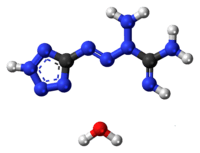Tetrazene explosive
-4-guanyl_tetrazene_hydrate.svg.png) | |
 | |
| Names | |
|---|---|
| IUPAC name
1-(5-tetrazolyl)-3-guanyl tetrazene hydrate | |
| Identifiers | |
| 31330-63-9 | |
| Jmol-3D images | Image |
| PubChem | 5486788 |
| |
| Properties | |
| C2H6N10·H2O | |
| Molar mass | 188.15 g/mol |
| Appearance | Pale yellow/colorless crystal plates |
| Density | 1.7 g/cm3 |
| Boiling point | Decomposes at 160 °C |
| Explosive data | |
| Shock sensitivity | High |
| Friction sensitivity | High |
| Detonation velocity | ~4000 m/s |
| Except where noted otherwise, data is given for materials in their standard state (at 25 °C (77 °F), 100 kPa) | |
| | |
| Infobox references | |
Tetrazene (1-(5-tetrazolyl)-3-guanyl tetrazene hydrate)[1] is an explosive material used for sensitization of the priming compositions. It is a derivative of the compound with the IUPAC name tetrazene.
Tetrazene is slightly more impact-sensitive than mercury fulminate. When pressed enough, its sensitivity is reduced or destroyed; this is known as dead pressing. It also decomposes in boiling water. In contact with fire, it readily explodes, producing large amounts of black smoke. It is prepared by reacting sodium nitrite with an aminoguanidine salt dissolved in acetic acid at 30–40 °C.
References
- "MIL-T-46938C, MILITARY SPECIFICATION: TETRACENE" (PDF). United States Department of Defense. 16 May 1994.
- ↑ Duke, J. R. C. (1971). "X-Ray crystal and molecular structure of ‘tetrazene’, (‘Tetracene’), C2H8N10O". Journal of the Chemical Society D: Chemical Communications 1971 (1): 2–3. doi:10.1039/C29710000002.